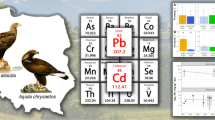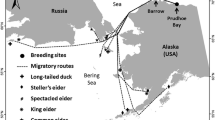Abstract
Selected elements were targeted in state Remedial Action Plans as one group of chemicals affecting the Beneficial Use Impairments of Great Lakes Areas of Concern (AOCs). Livers of nestling tree swallows, Tachycineta bicolor, were harvested from 76 sites in the Great Lakes, which included multiple sites at 27 AOCs and 12 reference sites from 2010 to 2015, and were analyzed for 21 elements. Mercury concentrations were at background levels at all sites. Elevated cadmium (Cd) concentrations were associated with industry. The highest Cd values were from the Black River, OH AOC and were associated with historic coke production but were not at toxic levels. Lead (Pb) concentrations were highest on the Rouge River, MI AOC—the oldest and most heavily populated and industrialized area in southeast Michigan. Individual Pb concentrations were elevated to a level associated with delta-aminolaevulinic acid dehydratase inhibition but not to a level considered toxic. In contrast, livers harvested from sites on the southwest shore of Lake Michigan had selenium (Se) concentrations elevated to levels associated with reduced avian reproduction. One likely source of the high Se concentrations was pollution from a local coal-fired power plant. Concentrations of the remaining elements were at background levels.
Access this article
We’re sorry, something doesn't seem to be working properly.
Please try refreshing the page. If that doesn't work, please contact support so we can address the problem.





Similar content being viewed by others
References
Alan RJ, Ball AJ, Cairns VW, Fox GA, Gilman AP, Peakall DB, Piekarz DA, Van Oosdam JC, Villeneuve DC, Williams DT (1991) Toxic chemicals in the Great Lakes and associated effects, vols I and II. Environment Canada, Department of Fisheries and Oceans, Health and Welfare Canada, Ottawa
AVMA (2013) AVMA Guidelines for the Euthanasia of Animals, 2013th edn. American Veterinary Medical Association, Schaumburg
Best D, Kubiak TJ, Boellstroff DE (1992) Survey of contaminants in sediment and biota within the Grassy Island confined disposal facility. Wyandotte National Wildlife Refuge: U.S. Fish and Wildlife Service, Division of Ecological Services, East Lansing Field Office, East Lansing, MI, Contaminants Program, 27 pp
Beyer WN, Stafford C (1993) Survey and evaluation of contaminants in earthworms and in soils derived from dredged material at confined disposal facilities in the Great Lakes region. Environ Monit Assess 24:151–165
Blancher PJ, McNicol DK (1991) Tree swallow diet in relation to wetland acidity. Can J Zool 69:2629–2637
Blus L, Henny CJ, Hoffman DJ, Grove RA (1995) Accumulation in and effects of lead and cadmium on waterfowl and passerines in northern Idaho. Environ Pollut 89:311–318
Brasso RL, Cristol DA (2008) Effects of mercury exposure on the reproductive success of tree swallows (Tachycineta bicolor). Ecotoxicology 17:133–141
Chasar LC, Scudder BC, Stewart AR, Bell AH, Aiken GR (2009) Mercury cycling in stream ecosystems. 3. Trophic dynamics and methylmercury bioaccumulation. Environ Sci Technol 43:2733–2739
Core Team R (2013) R: a language and environment for statistical computing. R Foundation for Statistical Computing, Vienna
Custer CM (2011) Swallows as a sentinel species for contaminant exposure and effect studies. In: Elliott JE, Bishop CA, Morrissey CA (eds) Wildlife ecotoxicology: forensic approaches, vol 3. Emerging topics in ecotoxicology. Springer, New York, pp 45–91
Custer CM, Custer TW (2000) Organochlorine and trace element contamination in wintering and migrating diving ducks in the southern Great Lakes since the zebra mussel invasion. Environ Toxicol Chem 19:2821–2829
Custer CM, Custer TW, Dickerson KM, Allen K, Melancon MJ, Schmidt L (2001) Polycyclic aromatic hydrocarbons, aliphatic hydrocarbons, trace elements and monooxygenase activity in birds nesting on the North Platte River, Casper, WY. Environ Toxicol Chem 20:624–631
Custer CM, Custer TW, Archuleta AS, Coppock LC, Swartz CD, Bickham JW (2003) A mining impacted stream: exposure and effects of lead and other trace elements on tree swallows (Tachycineta bicolor) nesting in the upper Arkansas River basin, Colorado. In: Hoffman DJ et al (eds) Handbook of ecotoxicology, vol 2. Lewis Publishers, Boca Raton
Custer CM, Custer TW, Warburton D, Hoffman D, Bickham J, Matson C (2006) Trace element concentrations and bioindicator response in tree swallows from northwestern Minnesota. Environ Monit Assess 118:247–266
Custer CM, Custer TW, Hill EF (2007a) Mercury exposure and effects of cavity-nesting birds from the Carson River, Nevada. Arch Environ Contam Toxicol 52:129–136
Custer TW, Custer CM, Dummer PM, Warburton D, Melancon MJ, Hoffman DJ, Matson CW, Bickham JW (2007b) Water level management and contaminant exposure to tree swallows nesting on the upper Mississippi River. Environ Monit Assess 133:335–345
Custer TW, Custer CM, Johnson KM, Hoffman DJ (2008) Mercury and other element exposure to tree swallows (Tachycineta bicolor) nesting on Lostwood National Wildlife Refuge, North Dakota. Environ Pollut 155:217–226
Custer CM, Yang C, Crock JG, Shearn-Bochsler V, Smith KS, Hageman PI (2009) Exposure of insects and insectivorous birds to metals and other elements from abandoned mine tailings in three Summit County drainages, Colorado. Environ Monit Assess 153:161–177
Custer TW, Custer CM, Thogmartin W, Dummer P, Kenow K, Meyer M (2012) Mercury and other element exposure in tree swallows nesting at low pH and neutral pH lakes in northern Wisconsin. Environ Pollut 163:68–76
Custer TW, Dummer P, Custer CM, Warburton D (2013) Dredging and contaminant exposure to tree swallows nesting on the Upper Mississippi River. Environ Monit Assess 185:9043–9053
Custer CM, Custer TW, Dummer PM, Goldberg D, Franson JC (2016) Concentrations and spatial patterns of organic contaminants in tree swallow (Tachycineta bicolor) eggs at US and binational Great Lakes areas of concern, 2010–2015. Environ Toxicol Chem 35:3071–3092
Custer TW, Custer CM, Dummer PM, Goldberg D, Franson JC, Erickson RA (2017a) Organic contamination in tree swallow (Tachycineta bicolor) nestlings at United States and binational Great Lakes Areas of Concern. Environ Toxicol Chem 36:735–748
Custer TW, Custer CM, Dummer PM, Bigorgne E, Oziolor EM, Karouna-Renier N, Schultz S, Erickson RA, Aagaard K, Mattson C (2017b) EROD activity, chromosomal damage, and oxidative stress in response to contaminants exposure in tree swallow (Tachycineta bicolor) nestlings from Great Lakes Areas of Concern. Ecotoxicology 26:1392–1407
Custer CM, Custer TW, Etterson MA, Dummer PM, Goldberg D, Franson JC (2018) Reproductive success and contaminant associations in tree swallows (Tachycineta bicolor) used to assess a beneficial use impairment in U.S. and Binational Great Lakes’ Areas of Concern. Ecotoxicology 27:457–476
Eisler R (2000) Handbook of chemical risk assessment health hazards to humans, plants, and animals, vols 1–3. Lewis Publishers, Boca Raton
Elliott JE, Scheuhammer AM, Leighton FA, Pearce PA (1992) Heavy metal and metallothionein concentrations in Atlantic Canadian seabirds. Arch Environ Contam Toxicol 22:63–73
Fitchko J, Hutchinson TC (1975) A comparative study of heavy metal concentrations in river mouth sediments around the Great Lakes. J Gt Lakes Res 1:46–78
Franson JC, Pain DJ (2011) Lead in birds. In: Beyer WN, Meador JP (eds) Environmental contaminants in biota: interpreting tissue concentrations, 2nd edn. CRC, Boca Raton, pp 563–593
Furness RW (1996) Cadmium in birds. In: Beyer WN, Heinz GH, Redmon-Norwood AW (eds) Environmental contaminants in wildlife: interpreting tissue concentrations. Lewis, Boca Raton, pp 389–404
Gasaway WC, Buss IO (1972) Zinc toxicity in the mallard duck. J Wildl Manag 36:1107–1117
Godwin MC, Smits JEG, Barclay RMR (2016) Metals and metalloids in nestling tree swallows and their dietary items near oil sands mine operations in Northern Alberta. Sci Total Environ 562:714–723
Heinz GH (1996) Selenium in birds. In: Beyer WN, Heinz GH, Redmon-Norwood AW (eds) Environmental contaminants in wildlife, interpreting tissue concentrations. SETAC Special Publication Series. Lewis, Boca Raton, pp 447–458
Hui CA (1998) Elemental contaminants in the livers and ingesta of four subpopulations of American coot (Fulica americana): an herbivorous winter migrant in San Francisco Bay. Environ Pollut 101:321–329
Johnson GD, Audet D, Kern JW, LeCaptain LJ, Strickland MD, Hoffman DJ, McDonald LL (1999) Lead exposure in passerines inhabiting lead-contaminated floodplains in the Coeur D’Alene River Basin, Idaho, USA. Environ Toxicol Chem 18:1190–1194
Koster MD, Ryckman DP, Weseloh DVC, Struger J (1996) Mercury levels in Great Lakes herring gull (Larus argentatus) eggs, 1972–1992. Environ Pollut 93:261–270
Llacuma S, Gorriz A, Sanpera C, Nadal J (1995) Metal accumulation in three species of passerine birds (Emberiza cia, Parus major, and Turdus merula) subjected to air pollution from a coal-fired power plant. Arch Environ Contam Toxicol 28:298–303
Marvin-DiPasquale M, Lutz MA, Brigham ME, Krabbenhoft DP, Aiken GR, Orem WH (2009) Mercury cycling in stream ecosystems. 2. Benthic methylmercury production and bed sediment-pore water partitioning. Environ Sci Technol 43:2726–2732
Mengelkoch JM, Niemi GJ, Regal RR (2004) Diet of the nestling tree swallow. Condor 106:423–429
Ohlendorf HM (1989) Bioaccumulation and effects of selenium. In: Jacobs LW (ed) Selenium in agriculture and the environment. Special Publication 23. Soil Science Society of America, Madison, WI, pp 133–177
Ohlendorf HM, Heinz GH (2011) Selenium in birds. In: Beyer WN, Meador JP (eds) Environmental contaminants in biota: interpreting tissue concentrations, 2nd edn. CRC, Boca Raton, pp 669–701
Sassa SA, Granick SS, Kappa A (1975) Effects of lead and genetic factors on heme biosynthesis in the human red blood cell. Ann N Y Acad Sci 244:419–440
See RB, Naftz DL, Peterson DA, Crock JG, Erdman JA, Severson RC, Ramirez P Jr, Armstrong J A (1992) Detailed study of selenium in soil, representative plants, water, bottom sediment, and biota in the Kendrick reclamation project. Water-Resources Investigation Report 91-4131. U.S. Geological Survey, Cheyenne, WY
Stapleton MK, Robertson RJ (2006) Female tree swallow home-range movements during their fertile period as revealed by radio-tracking. Wilson J Ornithol 118:502–507
Thompson DR (1996) Mercury in birds and terrestrial mammals. In: Beyer WN, Heinz GH, Redmon-Norwood AW (eds) Environmental contaminants in wildlife: interpreting tissues concentrations. Lewis Publishers, Boca Raton, pp 341–356
U.S. Department of Interior (1998) Guidelines for interpretation of the biological effects of selected contaminants in biota, water, and sediment. National Irrigation Water Quality Program Information Report 3. Denver, CO
Wiener JG, Knights BC, Sandheinrich MB, Jeremiason JD, Brigham ME, Engstrom DR, Cannon WF, Balogh SJ (2006) Mercury in soils, lakes, and fish in Voyageurs National Park (Minnesota): importance of atmospheric deposition and ecosystem factors. Environ Sci Technol 40:6261–6268
Acknowledgements
This work was funded by the Great Lakes Restoration Initiative (GLRI) and USGS, Environmental Health Mission Area. The authors thank Christopher Balk, Greg Berner, Crystal Bole, Peggy Boone, Rod Booth, Jr., Amanda Bosak, Andrew Haertel, Aaron Heimann, Yvette Hernandez, Melanie Iverson, Matthew Larkin, Adam Lorenz, Sean O’Mara, Ron Mayer, Patrick McKann, Karen McMullen, Melissa Meier, Kristina Artner Mott, Kelsey Prestby, Darin Ripp, Paul Ripple, Clif Schneider, Laura Solem, Dan Tagerson, Joshua Teslaa, Jocelyn Tschaikovsky, Max Weber, and Tesha Zimmerman for field assistance. This work could not have been done without the access granted by more than 75 landowners; their accommodations for our activities were greatly appreciated. The authors also thank Eileen Kirsch, Kevin Kenow, and two anonymous reviewers for helpful comments on earlier drafts of the manuscript.
Author information
Authors and Affiliations
Corresponding author
Ethics declarations
Conflict of interest
The authors declare that they have no conflict of interest.
Ethical Approval
This article does not contain studies with human participants, and all procedures performed were approved by the institution’s Animal Care and Use Committee.
Additional information
Disclaimer Any use of trade, firm, or product names is for descriptive purposes only and does not imply endorsement by the U.S. Government.
Electronic supplementary material
Below is the link to the electronic supplementary material.
Rights and permissions
About this article
Cite this article
Custer, T.W., Custer, C.M., Dummer, P.M. et al. Element Concentrations in Tree Swallows (Tachycineta bicolor) from the U.S. and Binational Great Lakes Areas of Concern. Arch Environ Contam Toxicol 76, 414–424 (2019). https://doi.org/10.1007/s00244-019-00601-4
Received:
Accepted:
Published:
Issue Date:
DOI: https://doi.org/10.1007/s00244-019-00601-4




